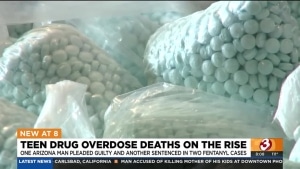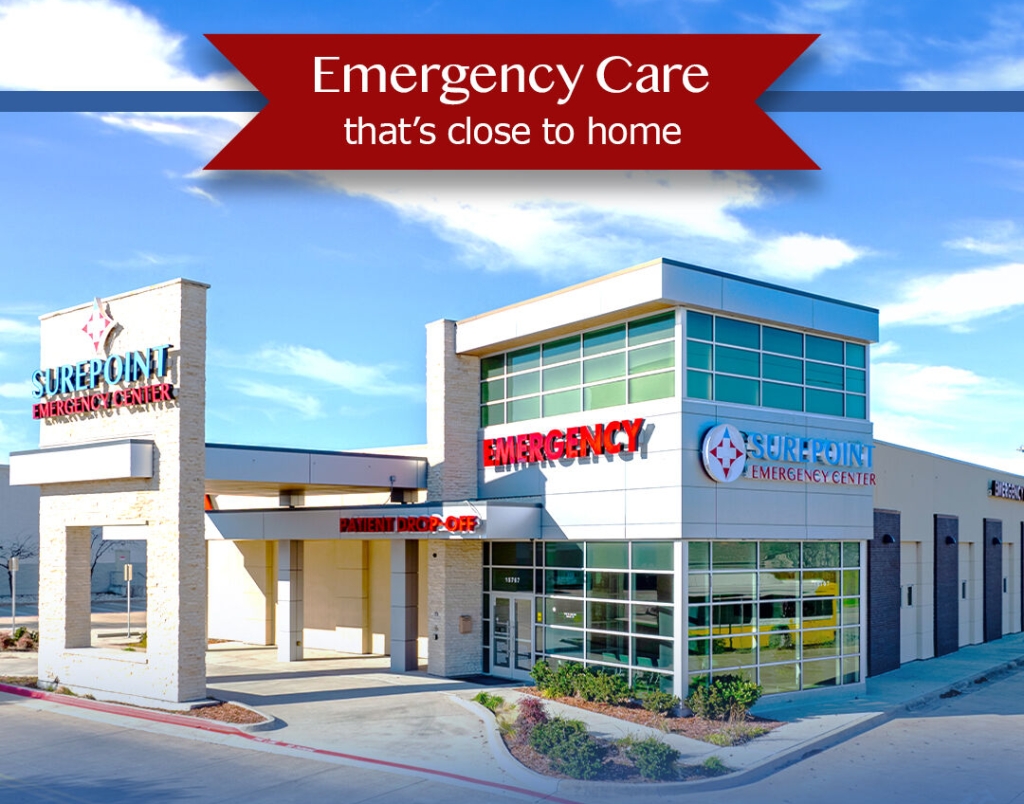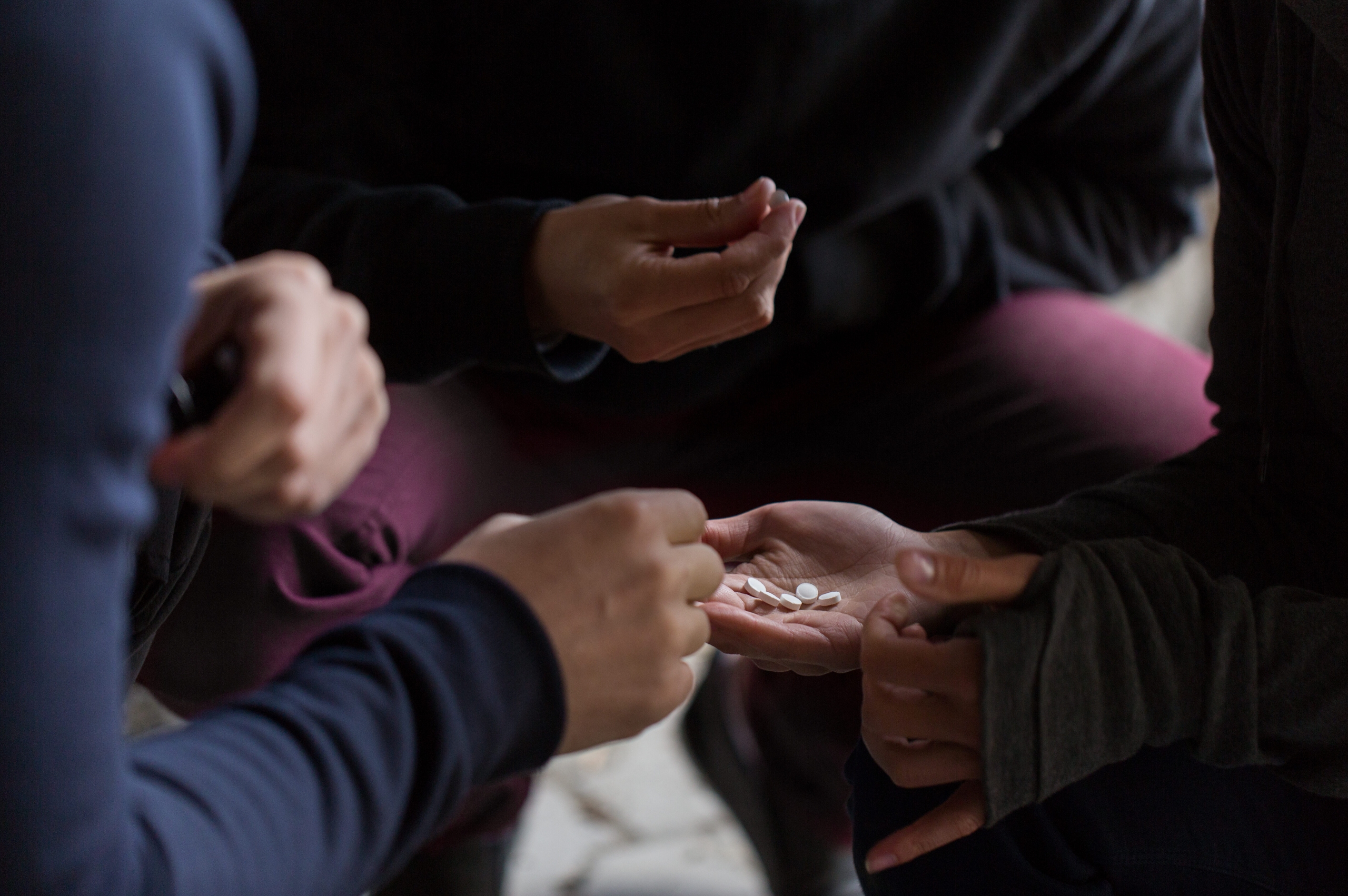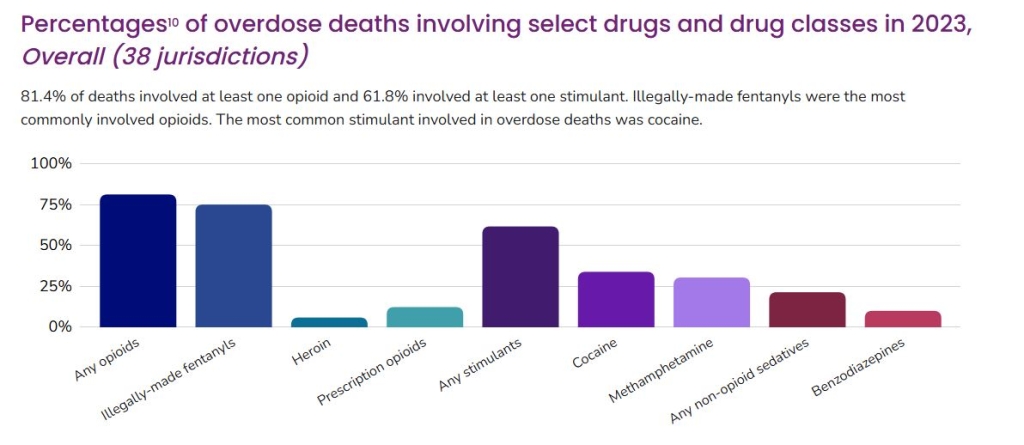Credit: Repost of CDC Facts Page
The CDC reports that one Synthetic opioids other than methadone, primarily illegally made fentanyl, were involved in approximately 68% of overdose deaths in the U.S. in 2022.6 Nonfatal and fatal overdoses involving fentanyl have risen sharply over the past decade.
What is fentanyl?
There are two types of fentanyl – pharmaceutical fentanyl and illegally made fentanyl. Both types are synthetic (lab-made) opioids.
- Pharmaceutical fentanyl is a synthetic opioid made by a drug company that is used for surgery or for treating severe pain, typically cancer pain.1 It is 50 to 100 times more potent than morphine.234 It is prescribed in the form of transdermal patches or lozenges and can be diverted for misuse.
- Illegally made fentanyl is a synthetic opioid available on the illegal drug market. It is most commonly found in powder form or pressed into counterfeit pills and can be smoked, snorted, injected, or ingested.5 Drugs mixed with fentanyl are extremely dangerous and many people might be unaware their drugs contain it.
- Powdered fentanyl looks just like many other drugs and can be mixed with drugs like heroin, cocaine, and methamphetamine.5
- Illegally made fentanyl is also increasingly pressed into counterfeit pills, commonly resembling oxycodone pills (e.g., M30 pills) or alprazolam pills (Xanax). Pharmaceutical fentanyl does not come in pill form.5
- Learn More: Fentanyl Facts
Deaths involving illegally made fentanyl are rising
Synthetic opioids other than methadone, primarily illegally made fentanyl, were involved in approximately 68% of overdose deaths in the U.S. in 2022.6 Nonfatal and fatal overdoses involving fentanyl have risen sharply over the past decade.789
- Nearly 74,000 drug overdose deaths involved synthetic opioids (other than methadone) in 2022. This is a nearly 5% increase from the number in 2021.7
- The rate of overdose deaths involving synthetic opioids (other than methadone) increased 4% from 2021 to 2022.7
- The rate of overdose deaths involving synthetic opioids (other than methadone) in 2022 was nearly 24 times the rate in 2013.7
Drugs may contain deadly levels of fentanyl, and you wouldn’t be able to see it, taste it, or smell it.
Test strips to detect fentanyl are inexpensive and typically give results within 5 minutes, which can be the difference between life or death. Even if the test is negative, take caution as test strips might not detect more potent fentanyl-like drugs, like carfentanil.10
What can be done?

The large number of overdose deaths involving fentanyl highlights the need to ensure people most at risk can access care, as well as the need to expand prevention and response activities. Additionally, there is the need to promote harm reduction by increasing the availability and access to high-quality harm reduction services, decreasing negative effects of substance use, and reducing stigma related to substance use and overdose.
In 2020, CDC issued a Health Alert Network Advisory to medical and public health professionals, first responders, harm reduction organizations, and other community partners recommending the following actions as appropriate based on local needs and characteristics:
- Expand distribution and use of naloxone and overdose prevention education
- Expand awareness about and access to and availability of treatment for substance use disorders
- Intervene early with individuals at highest risk for overdose
- Improve detection of overdose outbreaks to facilitate more effective response
Overdose Symptoms
An overdose on these drugs requires emergency medical care immediately. If you or your loved one experience any of the following symptoms Call 9-1-1 or get to your local Surepoint Emergency Center immediately:
- Not responding to other people
- Clammy skin, especially in the face
- A slow or uneven pulse rate
- Smaller “pinpoint” pupils
- A limp body
- Slow and shallow breathing
- Extreme sleepiness or sudden loss of consciousness
- Trouble speaking
- A bluish skin tone or dark color to the lips
- Making sounds like snoring, choking, or gurgling
Withdrawal Symptoms
If you use too much of an opiate or opioid too often, you can become physically dependent (your body now demands more of the drug) or addicted (you feel like you can’t stop taking it, even if it’s causing you problems).
Either way, you can go into withdrawal if you suddenly stop taking the drug. If you or our loved one has any of the following withdraw symptoms get to your local Surepoint Emergency Center:
- An intense craving for the opioid
- Feelings of anxiety or irritability
- An inability to sleep consistently
- Abdominal pains or cramps
- Throwing up or diarrhea
- Shakes and chills
- Sweating a lot
- Dilated (wider) pupils
- A runny nose and watery eyes
- Increased heart rate and blood pressure
Some of these symptoms can be dangerous, so withdrawing from an opiate or opioid without medical supervision is risky. See a doctor right away or dial 911 if your symptoms feel out of control.

 When it comes to your family’s health, every second counts. If you’re ever unsure about your loved one’s symptoms, it’s better to err on the side of caution. Surepoint Emergency Centers are here to provide peace of mind and expert care when you need it most.
When it comes to your family’s health, every second counts. If you’re ever unsure about your loved one’s symptoms, it’s better to err on the side of caution. Surepoint Emergency Centers are here to provide peace of mind and expert care when you need it most.
Your family’s health is our top priority. Let Surepoint Emergency Centers be there for you when it matters most.
To find the Surepoint Emergency Center close to you, use our locator tool below:
 Surepoint Emergency Center is a modern emergency medical facility open 24/7/365. As an alternative to the traditional hospital ER experience, we offer convenience and minimal wait time, along with highly-trained emergency medical staff and state-of-the-art equipment.
Surepoint Emergency Center is a modern emergency medical facility open 24/7/365. As an alternative to the traditional hospital ER experience, we offer convenience and minimal wait time, along with highly-trained emergency medical staff and state-of-the-art equipment.
Bringing high-quality emergency care, quickly and easily to your family is our top priority. Committed to making patients feel better faster in a comforting and compassionate environment is what we do.
Fast convenient care in your neighborhood.




